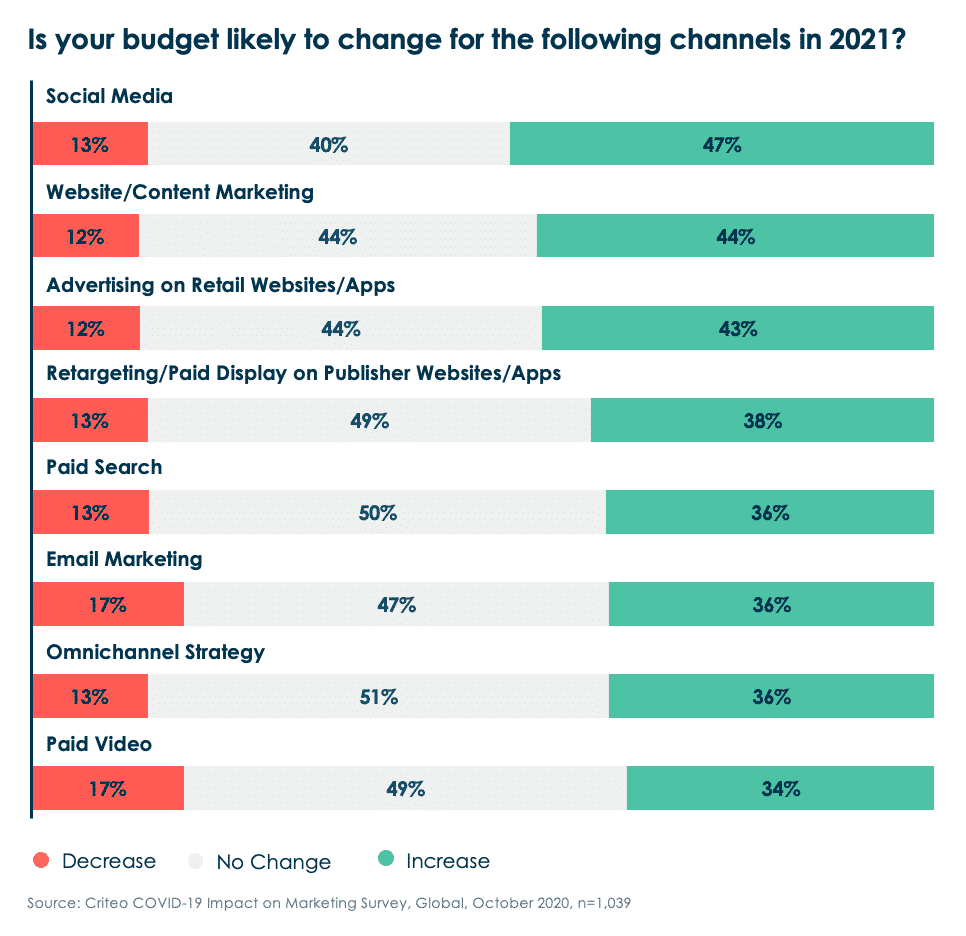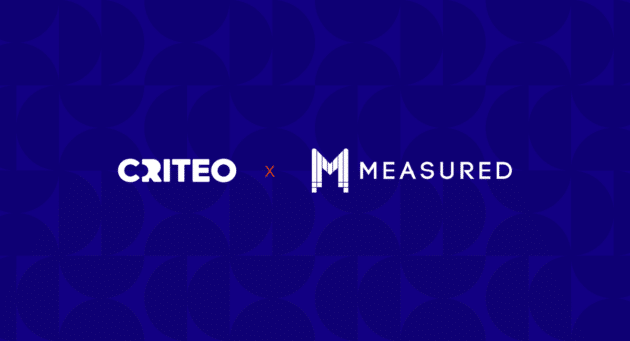Every aspect of the customer journey has become more digital. We’re using technology more than ever to discover, research, scrutinize, and buy all the products and services we need. In challenging times, nothing beats the convenience and choice digital commerce offers to the 2021 consumer.
To keep up with consumer habits, businesses are reallocating their marketing budgets. They’re increasing their investment in digital channels to reach consumers at every touchpoint that can influence their purchase decisions.
Criteo asked 1,000 senior marketing executives from around the world exactly how they’re adjusting their marketing budgets. According to our survey, every digital channel will attract more spend in 2021.1

However, as spend is increasing, digital advertising is also coming to a crossroads. Issues like cookies and brand safety are now centerstage. Digital publishers and media platforms are evolving to meet the new expectations of both marketers and consumers.
It’s important to stay aware of the ways digital advertising is changing as you reshape your strategy and invest more across digital channels. Below, we’re breaking down the top five industry challenges you need to know.
Download The 2021 Digital Advertising Manual: Rethinking Budgets & Channels for the New Customer Journey for commerce media strategies that help you face these challenges and drive results at every stage of the path to purchase:
Challenge #1: Proof of Impact
Every dollar from your budget must impact the bottom line.
As digital advertising budgets rise to record-breaking amounts, marketers are under pressure to prove that their investment in digital ad campaigns is driving measurable business results.
This means that metrics like video views and ad clicks must ladder up to core objectives like revenue and customer retention.
Challenge #2: Diversified Spend
Your advertising needs to reach consumers far beyond walled gardens.
One third of marketers think their campaigns are too dependent on Facebook, Google, and Amazon.1
Luckily, opportunities to diversify ad spend and engage audiences outside of search engines and social platforms abound—including on publisher sites and apps, retailer websites, and streaming platforms where consumers are increasingly browsing, shopping, and viewing content.
When we surveyed marketers, 43% said they plan to spend more on retail media in 2021. About 4 in 10 also plan to spend more on paid display and retargeting this year than they did in 2020.1
Challenge #3: Brand Safety
You have increasing concerns about where your ads are showing up.
Nearly 30% of marketers have concerns about brand safety and traffic quality when running digital marketing campaigns.1 Questions like, “Is there a risk that my digital ads will appear next to inappropriate or fake content?” and “What controls do I have to help keep my brand safe?” are now top of mind.
At the same time, consumers have growing concerns about social media, too. When Criteo surveyed over 1,000 social media users, we found that 55% are worried about seeing posts with fake news and misinformation.2
Challenge #4: Privacy Concerns
Consumers are concerned about how you’re using their personal information.
Marketers, publishers, and platforms need consumer data to create personalized experiences, but it’s becoming clear that people don’t understand exactly how their data is used. For example, in our social media study, 50% of consumers said they have concerns about their privacy and the personal information they share with social platforms.2
Personalization and online identity are evolving, and it’s important for marketers to pay attention to conversations about the future of third-party cookies.
Today, explore marketing tactics fueled by first-party data. In addition, show consumers the value exchange of advertising so that they’ll want to opt-in to personalized marketing in the future.
Challenge #5: Omnichannel Strategy
Your customers don’t think channel by channel—so you can’t either.
As consumers hop from channel to channel—email, social media, apps, websites, ecommerce sites, and even in-person, physical touchpoints—they’re having one experience. At minimum, businesses should create a consistent experience across their owned digital channels, such as a seamless flow from their website to their app.
An omnichannel strategy that accurately links behaviors across devices, environments, and media and sales channels gives marketers a full picture of their customers and the ability to deliver a cohesive experience.
For example, to provide valuable product recommendations and offers, marketers need to understand what their customers have browsed and purchased across desktop, mobile web, and app, as well as what they’ve bought in brick-and-mortar stores or through call centers.
Download The 2021 Digital Advertising Manual: Rethinking Budgets & Channels for the New Customer Journey to start adjusting your advertising strategy:
Are you an agency marketer? Download the Agency Edition of The 2021 Digital Advertising Manual: New Opportunities to Drive Client Growth for data and advertising strategies that will help you serve your clients in new ways.
1Criteo COVID-19 Impact on Marketing Survey, Global, October 2020, n=1,039
2Criteo State of Social Media Survey, US, Q4 2020, n=1,440























